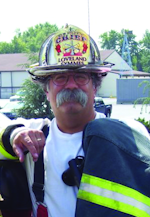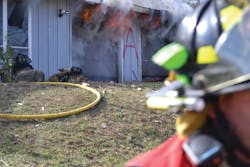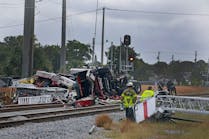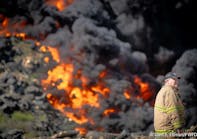Does any of this sound familiar?
A firefighter:
- Dies after falling from aerial ladder during training
- Dies after falling from a rope
- Dies while participating in a live-fire training evolution at an acquired structure
- Is critically burned after becoming injured during a live-fire evolution at a training academy and dies two days later
- Dies in a live-fire training exercise that injures four other firefighters
- Is killed in a flashover during a live-fire training evolution that injures two other firefighters
- Dies during a controlled burn
The above are just samples. We have quite a history of getting ourselves hurt or killed during training. Why? In most cases, it’s because we (from the command level to the firefighter level) get too comfortable. We drift from what we know and what we were taught, we get comfortable and we ignore standards, policy and common sense.
“It’s just training”
Sometimes, like I once did, we pass responsibility to someone else and the next thing you know, during a “break” between evolutions, firefighters are diving out of windows. We ignore what we know and how we might act at a “real” fire. After all, “it’s just training” is the conscious or “un”-conscious attitude that takes over what should be a high level of preparedness and risk management.
Here is a brief review of some incidents that impacted me in my career. It’s important that we understand history because it doesn’t have to repeat itself.
• Two Colorado firefighters killed (Jan. 26, 1982) – Four firefighters, including William J. Duran and Scott L. Smith, entered an old chicken coop for a supposed routine training exercise. Two other fire crews already had completed the exercise with no problem. Tires that had been set on fire for smoke in the exercise then ignited highly flammable fiberboard ceiling tiles.
Within seconds, the fire was rolling out of control. Duran, a 30-year-old engineer and father of three, and Smith, a 21-year-old who had joined the department just three months earlier, burned to death. Two other firefighters, Cyrus Pinkerton, who was supervising the training exercise, and Daniel Cutler, both escaped, but suffered serious burns. RIP.
• Three Michigan firefighters killed (Oct. 25, 1987) – This was training in arson recognition to let trainees see fire evidence before and after the fact. It would also provide “bonus” training in interior structural firefighting and in the use of self-contained breathing apparatus (SCBA). A tanker shuttle was to be used to supply water for the drill, providing an opportunity for all four departments to practice this method, and members of an Explorer Scout group were on hand to practice operating exterior handlines. The plan was to reignite the house and burn it to the ground after completion of the interior operations and examination of the evidence. Exterior 2½-inch hoselines were positioned to protect an exposed new house under construction on the same property.
Deaths and injuries occurred because of an “unanticipated” flashover on the ground floor that trapped six members on the upper level. Three of those members escaped, but three were killed as the fire rapidly extended to the second floor. All three deaths were attributed to inhalation of products of combustion, although all were wearing full protective clothing and SCBA. The dead firefighters included 41-year-old Marsha Baczynski of the Milford Township Volunteer Fire Department, Thomas Phelps, 34, of the Lyon Township, and 33-year-old Robert Gregory of the Highland Township Fire Department. The three injured firefighters were all members of the Milford department. RIP.
• New Jersey firefighters burned (Dec. 6, 1992) – Morris County’s Greystone Park Fire Department (GPFD) was conducting a Firefighter I class with 19 recruits from the area. Two officers from the GPFD taught the course, with one of the officers being a state-certified fire instructor. On that day, the class was held with just the one certified instructor and 18 of the recruits. The goal that day was to familiarize the recruits with real fire conditions. A 1976 bus, donated by the board of education, had been on site and used by the local fire department for two years. The seats were removed and steel plates were welded over the windows.
On that day, the fuel load in the bus consisted of a foam-cushioned couch, a hollow wood door, a tire and a five-gallon can containing a small amount of liquid fuel. Wood soaked in kerosene was placed in three sections of 55-gallon drums that had been cut in half to create heat and smoke. Shredded paper was placed under the foam cushions on the couch and a road flare was left under the cushions to ignite the fire.
The fire was allowed to burn for approximately 10 minutes before five students and the one instructor entered the bus. Between 30 seconds to a minute after they entered the bus, a flashover occurred. The instructor and two students exited the bus immediately and were uninjured. Two other students were able to exit on their own, but were injured. One student had to be removed from the bus and was severely injured.
• New York firefighter trainee killed (Sept. 25, 2001) – A Lairdsville, NY, fire training death led to the trial and conviction of Lairdsville’s former assistant fire chief for criminal negligence. The training detail killed 19-year-old firefighter trainee Bradley Golden and severely injured two other members. Golden, who had been a volunteer firefighter for only a few weeks, had not received any formal training and had never worn SCBA in fire conditions.
Golden and another firefighter were put on the second level of the duplex to play the role of trapped firefighters. They were placed in the front bedroom with some debris scattered about the floor and a Ping-Pong table actually placed on them to simulate entrapment. The “plan” included blocking the stairs of the unit leading to the trapped firefighters to simulate a stair collapse, so the fire companies would have to access the second floor via the stairs on the other side of the duplex and breach a wall.
Although a burn barrel had already been lit on the second floor, the first assistant chief also lit the foam mattress of a sofa downstairs. In a matter of seconds, it took off, with the area now involved with fire and nasty smoke.
One firefighter, already on the second floor, went to retrieve the “trapped firefighters,” but lost his fire gloves in the process, exposing his leather gloves underneath. The leather gloves immediately burned and adhered to his skin. He and the “trapped firefighters” became separated. The firefighter made it back to the bedroom with the burn barrel and frantically searched for the window that had been boarded shut to aid in the smoke conditions. He pried the window open with his hands and jumped from the second floor just as the first assistant chief arrived with the handline.
The two staged unknowing engine companies proceeded to the scene under normal driving conditions as planned, and once on scene were informed that two firefighters really were down on the second floor and that one firefighter had jumped from the second-story window. The companies, now in total surprise as this training turned to reality, deployed a rapid intervention team.
Golden was unresponsive when he was removed and was pronounced dead at the hospital. The cause of his death was listed as asphyxia due to smoke inhalation. The two other firefighters who were on the second floor during the incident suffered severe burns and were airlifted to an area burn unit. RIP.
• Two Florida firefighters killed (July 30, 2002) – A foam-rubber mattress was used to fuel a fire during training. Again, there was a flashover. This time, two Osceola County firefighters, Osceola County Fire Department Lieutenant John Mickel and rookie firefighter Dallas Begg were killed. RIP.
Now, after looking at some history, we have the opportunity to learn again, directly from a firefighter who became another victim of “live-fire” training. My sincere thanks to Wisconsin Firefighter Candace Wetter for sharing this story and passing on the details so that we have a chance to learn.
“The worst day of my life” – A personal account by Firefighter Candace Wetter:
I come from a family of firefighters and this year would mark my fifth year in the fire service. I started out in the fire service as a junior firefighter for a volunteer fire company. I worked my way into a firefighter position on my 18th birthday. Since the day I started in the fire service, I have diligently strived to be better. I took fire classes while still in high school while balancing multiple part-time jobs, classes, softball and track teams and Future Farmers of America activities. The fire service was what I lived for, it was my everything, and I couldn’t wait to graduate from high school and start my career.
That wish came true in the May 2012. I was hired as an intern firefighter/EMT with a combination department in Wisconsin. I also was hired as an adjunct fire instructor for Southwest Wisconsin Technical College, specializing in the instruction of firefighter survival and rapid intervention. Besides the local level, I am also a Wisconsin Advocate for the National Fallen Firefighters Foundation (NFFF) Everyone Goes Home Program.
On Oct. 27, 2012, my department was invited to attend a multi-department live-fire training burn in an acquired structure. It was a two-story, ordinary construction building. Our burn room was in the garage, which was three feet below the foundation of the house.
It was right after lunch, when some of the instructors asked us if we wanted to go in for the last burn. Who would turn that down? We grabbed our gear and went to the Charlie side of the house. We had already done a walk-through that morning. We were standing on the back porch doing gear checks and bleeding the hoseline. Everyone was ready. I was on a four-person crew. The nozzleman was in front of me, I was second on the line, making me the officer of the crew, the third person on the line was my best friend and one more person made up the crew.
Making entry
Right before we made entry, the third man asked me if he could do the radio report to command. I said sure and let him do it. He called command and we made entry. To our right, there was a small rekindle from a previous burn. I told my nozzleman to put it out and he did. We then turned to our left and opened the door to the burn room. The first thing I did was look at the crib in the corner. It looked fine. I know I will sound complacent when I say this, but it looked like any other fire I had fought before. I am by no means a veteran or senior firefighter, but I would not have sent my crew in that room if it didn’t look like it did. I do not consider myself an experienced firefighter, but it was a fightable fire (at least it appeared that way).
My nozzleman and I entered the room and sat down approximately six feet away from the crib. I then looked behind me to make sure my third and fourth crew members were there, but they weren’t. The first thing I thought was that the instructors were just messing with me, seeing what I would do if they pulled my crew members away. So I yelled my third man’s name three times.
I remember looking back at the open door, seeing the light, expecting them to show up. Hoping they were coming. My nozzleman, who was new to our department and a less-experienced firefighter, was getting anxious. I could easily tell. He said, “Candace, what do I do, what do I do?” I told him that we were fine; I was just trying to find our third and fourth crew members.
I then looked back again toward the door, still waiting for the arrival of my third and fourth crew members. Still nothing. I yelled his name again, three more times. This time louder and now I am starting to get anxious. My nozzleman kept saying over and over again, “Candace, what do I do, what do I do?”
Again, I said, “We’re OK, keep calm.” I told him to open the bale; he did and hit the fire, which wasn’t even into the rollover stage. I looked back one last time for my third and fourth crew members, yelling his name three more times, and that’s when the smoke that was above our heads dropped to the floor. It was the blackest smoke I have ever seen in my life. With the smoke it brought unbearable heat. I knew something was going horribly wrong and I knew we needed to leave.
I quickly stuck one hand out on the right side of our hoseline, swept within arm’s length, then stuck a leg out on the left side of the hoseline and swept, searching for my best friends. The first thing that started to burn was my ears. It was like someone was taking knives, stabbing my body over and over again.
I said to my nozzleman “We need to leave now,” but he didn’t move. So I said it louder, “We need to leave now.” Still, he didn’t move. I then grabbed his SCBA strap and started pulling. I was in low crouch because of the needed leverage to pull him. He was lying down. My left hand pulled his SCBA strap and my right hand swept in front of me, looking for our way out.
Our hoseline was being pulled away from us by someone outside. My mask was melting and the dark smoke made visibility impossible. I just kept sweeping, feeling for a wall or stairs, anything. As soon as I felt that step, the room flashed on us.

Billy Goldfeder
BILLY GOLDFEDER, EFO, who is a Firehouse contributing editor, has been a firefighter since 1973 and a chief officer since 1982. He is deputy fire chief of the Loveland-Symmes Fire Department in Ohio, which is an ISO Class 1, CPSE and CAAS-accredited department. Goldfeder has served on numerous NFPA and International Association of Fire Chiefs (IAFC) committees. He is on the board of directors of the IAFC Safety, Health and Survival Section and the National Fallen Firefighters Foundation.






